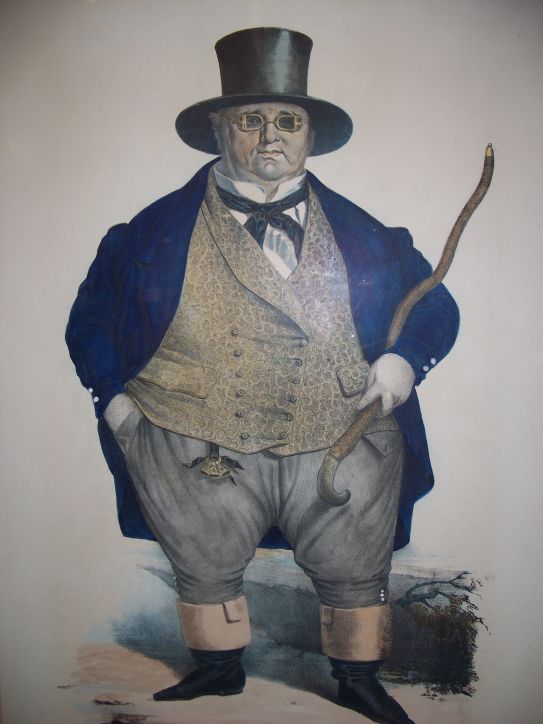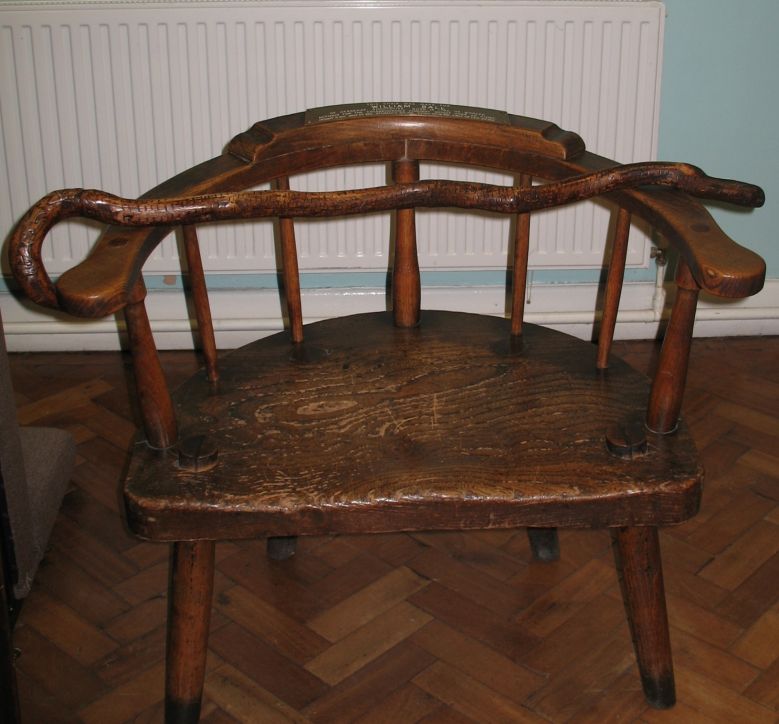Biography of William Ball
William Ball - The Shropshire Giant
by Shirley Bruneau
 |
| (© Courtesy of Ironbridge Gorge Museum Trust) |
William Ball was an interesting character, born in Horsehay, Great Dawley in 1795 and baptised on the 8th. July of that year. He was the first son born to Thomas and Elizabeth Ball and one of five children. He gained his notoriety in the 19th C because of his size. He was five feet nine and half inches tall and at his heaviest he was said to weigh over forty stones, hence the title given to him of the ‘Shropshire Giant’. His measurements were taken when he exceeded forty stone in weight. It was said that “his waist coat was so big that 3 men could be buttoned into it.”
He married twice in his life: firstly to Mary Bailey in September 1819 and she bore him two children: Eliza born August 1823 and Thomas born in August 1824. Sadly Eliza died in infancy and Thomas in 1839. His wife Mary also died in October 1824 and in 1825 he married for a second time to Margaret Wood who was five years older than him. They had no children and she is believed to have died in 1850.
He was known to be, despite his size, a very active and jocular man with a retentive memory and a very pleasant disposition.
From the age of eight years, he was employed as a puddler in the Horsehay Ironworks, which was owned by the Coalbrookdale Company. He later progressed to being a shingler at the works. In the 1841 census he has given his occupation as a forgeman. He worked at Horsehay for 40 years for the company and was known to be very strong. ‘Billy’, as he was known, lifted on his own, without any mechanical aid, a piece of iron from the ball furnace weighing almost nine hundred weight to place under the forge hammer. He only left the Ironworks after being blinded in one eye by a piece of molten iron. From that time on he wore thick lens glasses.
 When he left employment in Horsehay Ironworks, he was exhibited round the county fairs as the largest man in Britain, going under the pseudonym of ‘John Bull’. In 1850 he was chosen as one of two men to lead a procession to celebrate the birth of Alfred Darby II. “Big Billy Ball” because of his massive bulk, had to be hoisted onto his horse by a specially constructed pulley and blocks, whilst his co-leader “Little Bennie Poole”, as the smallest man in the employ of the Coalbrookdale company, was mounted on a pony for contrast. Billy was said to exclaim as he mounted “Dunno yo drop me!” His sturdy horse had to be destroyed after the procession because Billy’s weight had broken its back!
When he left employment in Horsehay Ironworks, he was exhibited round the county fairs as the largest man in Britain, going under the pseudonym of ‘John Bull’. In 1850 he was chosen as one of two men to lead a procession to celebrate the birth of Alfred Darby II. “Big Billy Ball” because of his massive bulk, had to be hoisted onto his horse by a specially constructed pulley and blocks, whilst his co-leader “Little Bennie Poole”, as the smallest man in the employ of the Coalbrookdale company, was mounted on a pony for contrast. Billy was said to exclaim as he mounted “Dunno yo drop me!” His sturdy horse had to be destroyed after the procession because Billy’s weight had broken its back!
On the 30th April Census 1851 William is listed, aged 55, with no occupation. Yet this is the year that he came to national prominence when he attended the Great Exhibition as a celebrity guest/exhibit. He went by train to London, travelling in the guard’s carriage as there was no passenger seat big enough to take his size. At Birmingham, it is said that some businessmen came on board and started teasing him about his size: they asked him how much material would be needed and what the cost would be to make him a suit, but after he quipped that if they would take him to a tailor, have him measured and pay for a suit, he would give them the information they wanted, they troubled him no more!
Although Billy had the honour of being a celebrity at the Crystal Palace, his experience of the capital was tainted by falling prey to thieves and he left never wishing to return. This was to be his greatest and last major public appearance as he died in June 1852 at the age of fifty six years. However a larger than life character had an unusual burial: he was taken from his residence in Sandy Bank Row (since demolished). His coffin was so large that “10 lads were able to lie in it at the same time and it took 10 of the strongest men in the district to carry his coffin… even then they had the assistance of poles and straps to assist them.” He was buried in an unmarked grave at St Luke’s Church in Doseley.
References
1.Shropshire Life Magazine, March 1952, p19
2. A puddler stirred the molten pig iron in the furnace
3.A shingler forged the ball of puddled iron after it was removed from the furnace
4.Shropshire Life Magazine, January 1971, p21
5.Shropshire Life Magazine, March 1952, p19
6.Shropshire Life Magazine, January 1971, p21


